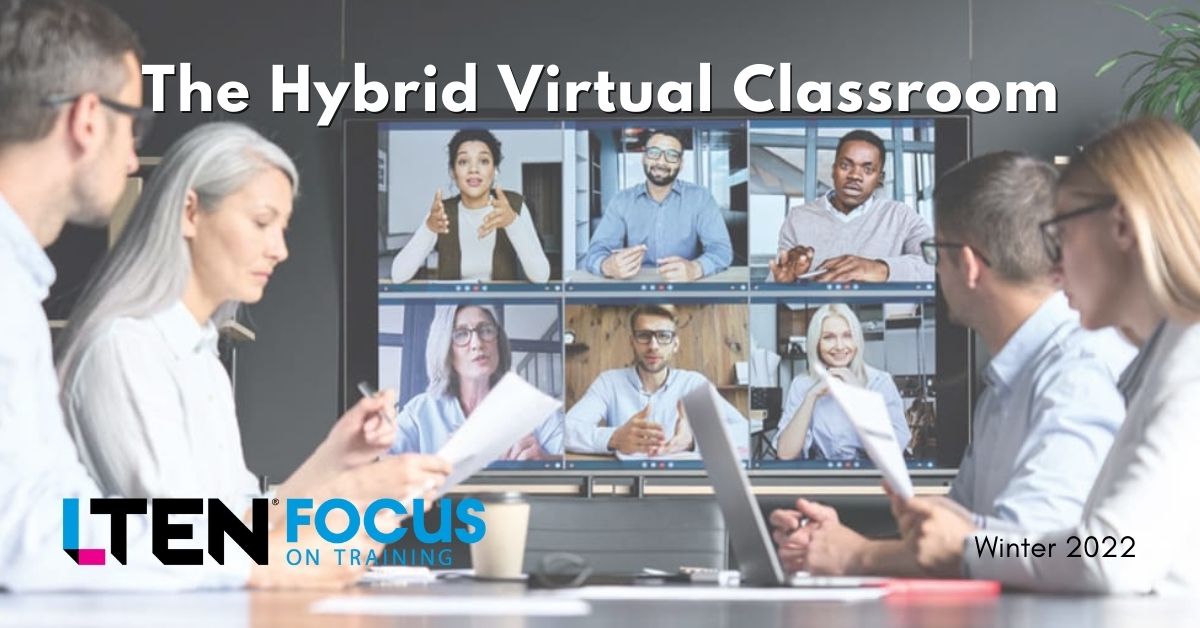
The Hybrid Virtual Classroom
Virtual Training – Cindy Huggett, CPTD
The differences between in-person and virtual require attention.
 As organizations around the globe return to offices after the COVID-19 pandemic, they are faced with decisions about how to handle in-person classes. For some organizations, it’s a simple decision to go back to the traditional classroom. For others, it’s best to continue virtual learning.
As organizations around the globe return to offices after the COVID-19 pandemic, they are faced with decisions about how to handle in-person classes. For some organizations, it’s a simple decision to go back to the traditional classroom. For others, it’s best to continue virtual learning.
But many organizations find themselves needing to create a mixed learning environment with some participants in-person, others online. This is called a hybrid class – one that has a mixture of in-person and online audiences.
The unique challenge of hybrid classes is the vastly different participant experience among attendees. The in-person audiences benefit from being together and with the facilitator. The remote participants are isolated both from the group and from each other. But they have access to robust software tools found in the virtual classroom software.
One experience isn’t better than the other, but the differences require attention to have a successful class.
Tips for Success
Here are five important design and facilitation tips to consider for hybrid classes:
1. Equalize: Do your best to create an equal experience for all participants. This means asking all participants to join the virtual classroom platform, even if they are attending in-person. This way, everyone has the same tools for learning. For example, everyone can raise an electronic hand, and everyone can respond to poll questions. In addition, everyone can type in chat, and use whiteboard tools. By giving everyone the same set of tools, it helps create a more inclusive environment for all.
2. Revise: Review your training content and revise participant activities to accommodate the mixed audience.
For example, if you have breakouts planned, determine the best way to sort everyone into groups. Will you mix and match attendees into breakout rooms? Or will you ask the in-person audience to get into teams, while having the remote audience members work in separate groups? Both methods have advantages, but don’t leave this decision up to chance. Or if you plan to have a brainstorm activity, how will both audience types get their ideas captured on the whiteboard? Be deliberate in every exercise so that all attendees can participate.
3. Prioritize: Facilitators should place emphasis and priority on the remote participants. By allowing them to talk first in a discussion, it recognizes their limitation of being online and can help them feel more connected to the class. It’s so easy for the in-person audience to have the floor in a conversation, the deliberate attempt to draw in the offsite crowd will create a better sense of balance.
4. Personalize: Facilitators should also focus on each participant and attempt to draw everyone into group discussions. The goal is to include and invite each person into the learning space. For example, when asking questions, the facilitator can phrase them in ways that let everyone know their input will be valued, such as, “There are 15 of you, so let’s get 15 responses before we dive deeper into this topic.” By asking inclusive questions and allowing time for remote attendees to respond, it keeps your attention on every learner.
5. Organize: Finally, it’s important to recognize the special technology requirements of hybrid virtual classes. Not only do you want everyone to be logged into the virtual classroom, you also want to ensure smooth connections and a seamless experience. Therefore, create organized technology guidelines for using tools, especially audio and video.
For example, have only one audio pathway for the in-person group to avoid echoes. Establish protocols for turning on webcams so that everyone can see. Have a producer or co-facilitator available to manage technology needs. By establishing guidelines, you will have a much more organized program.
Conclusion
In closing, one of my favorite techniques for facilitating hybrid virtual classes is to create a buddy system, to match up each online participant with someone in-person. Ask them to create a communication back-channel so that they can be each other’s eyes and ears throughout the workshop.
By sharing the responsibility of learning success with everyone in the classroom, you’re more likely to have attention, engagement and, ultimately, achieve learning results.
Cindy Huggett, CPTD, is a consultant whose books include Virtual Training Tools
and Templates and The Virtual Training Guidebook. Email her at cindy@cindyhuggett.com.








